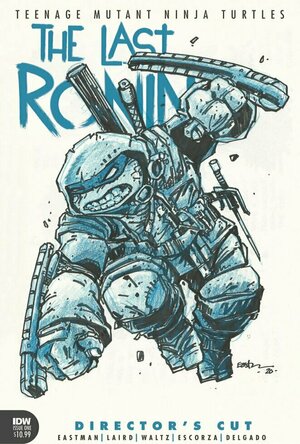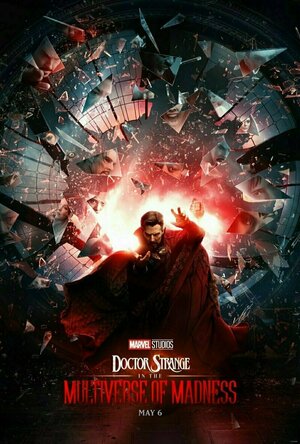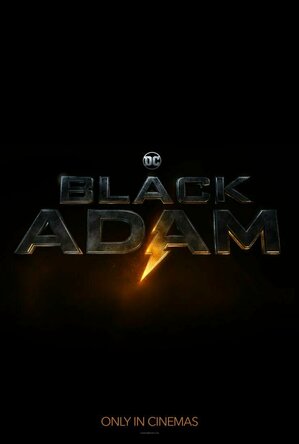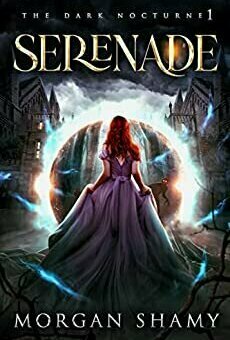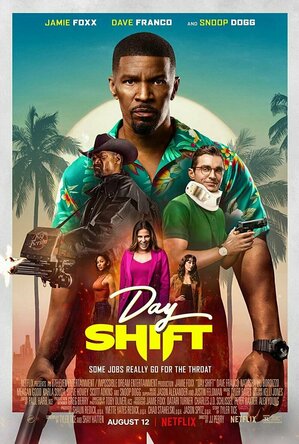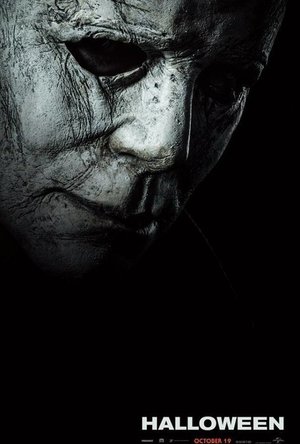Search
Search results

Beat Fever: Music Rhythm Game
Games and Entertainment
App
Get your fingers ready for the ultimate music game! Beat Fever is an easy to learn, hard to master...

MARVEL Spider-Man Unlimited
Games and Entertainment
App
*** OVER 200 CHARACTERS FROM THE SPIDER-VERSE TO PLAY! *** Collect and unite every Spider-Man and...
Charlie Cobra Reviews (1840 KP) rated Teenage Mutant Ninja Turtles: The Last Ronin #1 - Director's Cut in Books
Sep 16, 2021
Lone Turtle On A Quest For Revenge
New York City has become a dark and depressing place as the Foot Clan has taken over quadrants of the city, with "synthetic ninja" or "synja's". It's ruled by totalitarianism and meticulous fascism at the hands of Oroku Hiroto, grandson of the Shredder. The last of the Ninja Turtles works hard to end Hiroto's evil reign. Alone and outnumbered he seeks to avenge his dead brothers, a seemingly hopeless mission and kill Hiroto, whom he blames for their murders.
So first off I think this comic is pretty bad ass. I had heard about it and decided to check it out and I totally liked the whole premise for it and how the story plays out in this first issue. The artwork was nice and there was plenty of action but what hooked me was the whole quest for revenge. I think I've said it before but if you don't know this about me, I'm a sucker for a good revenge story. I don't know what it is about being wronged or having something so bad happen to the hero/protagonist in stories but I immediately put myself in their place and think about what I would do if I was them. Plus it's always satisfying to see the bad guy get his "just desserts". I have to say that I'm a huge TMNT fan but I've actually never really read any of the comic stuff. I remember reading a crossover or team up of them with Erik Larsen's Savage Dragon but that's about the only thing I've ever seen or checked out before. So I might be a little biased but the story is also really compelling.
I like the way it starts off with the lone ninja turtle making his way into the city, sneaking into the Foot controlled zone by climbing over the wall. How they complain about the water being ruined from global warming and years of pollution as he has to swim through it. I like how people are talking to him the whole time and it's a shock to find out who they are. I really like the artwork, like the character designs and how they make it a mystery as to which Ninja Turtle is the one who survived. They even make him use various weapons instead of their signature one to keep the mystery going throughout the issue. I liked the way the city looked, it had modern looking places and but then futuristic parts with flying cars and stuff too. There's plenty of action as they take on plenty of "synja's" as well as elite ninja and some "Stockman tech", mainly some flying "mousers". Don't want to give away too much since this is my first comic book review and haven't figured out a format for it yet and if I'm going to do non-spoiler/spoiler style or not but I think this is where I'll leave it for now.
So first off I think this comic is pretty bad ass. I had heard about it and decided to check it out and I totally liked the whole premise for it and how the story plays out in this first issue. The artwork was nice and there was plenty of action but what hooked me was the whole quest for revenge. I think I've said it before but if you don't know this about me, I'm a sucker for a good revenge story. I don't know what it is about being wronged or having something so bad happen to the hero/protagonist in stories but I immediately put myself in their place and think about what I would do if I was them. Plus it's always satisfying to see the bad guy get his "just desserts". I have to say that I'm a huge TMNT fan but I've actually never really read any of the comic stuff. I remember reading a crossover or team up of them with Erik Larsen's Savage Dragon but that's about the only thing I've ever seen or checked out before. So I might be a little biased but the story is also really compelling.
I like the way it starts off with the lone ninja turtle making his way into the city, sneaking into the Foot controlled zone by climbing over the wall. How they complain about the water being ruined from global warming and years of pollution as he has to swim through it. I like how people are talking to him the whole time and it's a shock to find out who they are. I really like the artwork, like the character designs and how they make it a mystery as to which Ninja Turtle is the one who survived. They even make him use various weapons instead of their signature one to keep the mystery going throughout the issue. I liked the way the city looked, it had modern looking places and but then futuristic parts with flying cars and stuff too. There's plenty of action as they take on plenty of "synja's" as well as elite ninja and some "Stockman tech", mainly some flying "mousers". Don't want to give away too much since this is my first comic book review and haven't figured out a format for it yet and if I'm going to do non-spoiler/spoiler style or not but I think this is where I'll leave it for now.
Night Reader Reviews (683 KP) rated A Deadly Education: Lesson One of the Scholomance in Books
Sep 22, 2021
Rough start for a new series but shows promise
A Deadly Education by Naomi Novik was given eighth place in the Goodreads choice awards for fantasy last year and has been nominated again this year. Unfortunately this book will not be receiving my vote although at this time I have not yet decided which book I will be voting for. This is the first book in a new series and I do have high hopes that future editions to the series will be better as it shows a lot of promise.
The basic idea here is that magical children are teleported away to The Scholomace for education and safety from the mals ( evil creatures attracted to the easy target of young magic user) though not all make it into the school. The school itself is dangerous as well yet even with the horde of mals waiting at the graduation gates to feast on everyone trying to leave the school once a year and the few who make it into the rest of the building the survival rate os those inside the school is still better than if they were left in the general magical population.
While completing school work is important it only because the school will attack those who don't complete their work the samation of alliances is almost more important. This is problematic thoug for those who don't come from an enclave and who are not interested n making friends in the first place.
What I liked about this book was that it is relatively unique. The fact that the main character actually goes through a very clear mental and maturity growth is a plus as well. She really improves as she learns about herself and her classmates. Unfortunately that is pretty much everything good I can say about this book. I enjoyed reading the book when I first started it but around halfway through it became clear that a lot of the book is repetitive. The book ended up becoming slow with the group just fighting off mals and not making much progress on the storyline for a while.it actually got to the point that I was about ready to put the book down.it is also rather predictable.
The ideal target audience for this book is teens to some young adults. I believe the book is too much for most readers younger than teens but at the same time it lacks the detail and depth needed to really capture the attention of older readers. I can only rate this book a 2 out of 5 at best with the hope that it is just a slow start to a good series.
For more reviews on popular books and independent authors check out these locations
https://www.facebook.com/nightreaderreviews
https://smashbomb.com/nightreader
https://nightreaderreviews.blogspot.com/
https://www.goodreads.com/user/show/40248897-melissa-espenschied
To see about having your book reviewed a message on any of the above platforms or email me at bookreviewsatnight@gmail.com
Thank you, Melissa
The basic idea here is that magical children are teleported away to The Scholomace for education and safety from the mals ( evil creatures attracted to the easy target of young magic user) though not all make it into the school. The school itself is dangerous as well yet even with the horde of mals waiting at the graduation gates to feast on everyone trying to leave the school once a year and the few who make it into the rest of the building the survival rate os those inside the school is still better than if they were left in the general magical population.
While completing school work is important it only because the school will attack those who don't complete their work the samation of alliances is almost more important. This is problematic thoug for those who don't come from an enclave and who are not interested n making friends in the first place.
What I liked about this book was that it is relatively unique. The fact that the main character actually goes through a very clear mental and maturity growth is a plus as well. She really improves as she learns about herself and her classmates. Unfortunately that is pretty much everything good I can say about this book. I enjoyed reading the book when I first started it but around halfway through it became clear that a lot of the book is repetitive. The book ended up becoming slow with the group just fighting off mals and not making much progress on the storyline for a while.it actually got to the point that I was about ready to put the book down.it is also rather predictable.
The ideal target audience for this book is teens to some young adults. I believe the book is too much for most readers younger than teens but at the same time it lacks the detail and depth needed to really capture the attention of older readers. I can only rate this book a 2 out of 5 at best with the hope that it is just a slow start to a good series.
For more reviews on popular books and independent authors check out these locations
https://www.facebook.com/nightreaderreviews
https://smashbomb.com/nightreader
https://nightreaderreviews.blogspot.com/
https://www.goodreads.com/user/show/40248897-melissa-espenschied
To see about having your book reviewed a message on any of the above platforms or email me at bookreviewsatnight@gmail.com
Thank you, Melissa
Lyndsey Gollogly (2893 KP) rated Tenacity ( Rise of Iliri book 5) in Books
Feb 1, 2022
Contains spoilers, click to show
❗️❗️❗️ spoiler in last paragraph!‼️‼️
20 of 230
Kindle
Tenacity ( Rise of Iliri book 5)
By Auryn Hadley
WAR, HEARTBREAK, MORE WAR... AND A NEW FRIEND
In the fifth heart-stopping tale of her epic fantasy series The Rise of the Iliri, Auryn Hadley interjects a compelling sci-fi action fantasy with an emotionally charged reverse harem romance, setting the heart-warming experience of everyday community against the heart-wrenching reality of war - and the loss it causes. A jarring emotional roller coaster, Tenacity tells the age-old tale of pure love amidst a struggle between good and evil - but with a heaping dose of the light-hearted, cross-cultural birds and bees. This one has plenty of laughs. And plenty of heartbreak.
Slowly, region by region, the Lieutenant Salryc Luxx and her elite Black Blades are pushing forward and liberating an enslaved nation from the emperor's reign of terror. But the battle's not without consequence.
While scoping out the quiet remains of a fallen town - too quiet, actually - they discover scores of slaughtered families. But they also discover life: a young girl, locked in a cage below a tavern. No one is certain exactly what she is. She has unusual streaks of red, blonde, and white hair, and two different-colored eyes. She's fluent in iliri language, and she's terrified. So terrified that when an officer approaches to unlock her, her fear burns a hole in his armor.
The girl's name is Shaden. She's too young to know what exactly her talents are, or how to control them, but she's powerful. Immediately recognizing Sal as the fabled Kaisae, she trusts only Sal. Meanwhile, as the Black Blades continue their assault on a city thought to be impenetrable, Shaden manages to harness her power to help keep her newfound family of warriors safe. But for Sal's part, Shaden triggers difficult emotional memories of her own enslavement as a girl. And her longing to free anyone she can
With every win, Sal is bombarded by the thanks of those she rescued, and the disdain of those whose families she could not save. She can't sleep, she can't eat ... but she cannot stop fighting, either.
Victory is near. The Emperor is losing. He knows this. He knows Sal's responsible, and he knows exactly how to destroy her - go after those she loves most.
There’s me going a long nicely really enjoying the book and being back with Sal and her guys the Bam!!!! Not only does Balaec get killed in front of her she has to watch the dogs eat him! My heart broke this was a character death I won’t forget in a hurry poor Sal. Poor black blades. This was another brilliant book from a series I absolutely love! I just need to hide this one in the freezer (if you know you know) .
20 of 230
Kindle
Tenacity ( Rise of Iliri book 5)
By Auryn Hadley
WAR, HEARTBREAK, MORE WAR... AND A NEW FRIEND
In the fifth heart-stopping tale of her epic fantasy series The Rise of the Iliri, Auryn Hadley interjects a compelling sci-fi action fantasy with an emotionally charged reverse harem romance, setting the heart-warming experience of everyday community against the heart-wrenching reality of war - and the loss it causes. A jarring emotional roller coaster, Tenacity tells the age-old tale of pure love amidst a struggle between good and evil - but with a heaping dose of the light-hearted, cross-cultural birds and bees. This one has plenty of laughs. And plenty of heartbreak.
Slowly, region by region, the Lieutenant Salryc Luxx and her elite Black Blades are pushing forward and liberating an enslaved nation from the emperor's reign of terror. But the battle's not without consequence.
While scoping out the quiet remains of a fallen town - too quiet, actually - they discover scores of slaughtered families. But they also discover life: a young girl, locked in a cage below a tavern. No one is certain exactly what she is. She has unusual streaks of red, blonde, and white hair, and two different-colored eyes. She's fluent in iliri language, and she's terrified. So terrified that when an officer approaches to unlock her, her fear burns a hole in his armor.
The girl's name is Shaden. She's too young to know what exactly her talents are, or how to control them, but she's powerful. Immediately recognizing Sal as the fabled Kaisae, she trusts only Sal. Meanwhile, as the Black Blades continue their assault on a city thought to be impenetrable, Shaden manages to harness her power to help keep her newfound family of warriors safe. But for Sal's part, Shaden triggers difficult emotional memories of her own enslavement as a girl. And her longing to free anyone she can
With every win, Sal is bombarded by the thanks of those she rescued, and the disdain of those whose families she could not save. She can't sleep, she can't eat ... but she cannot stop fighting, either.
Victory is near. The Emperor is losing. He knows this. He knows Sal's responsible, and he knows exactly how to destroy her - go after those she loves most.
There’s me going a long nicely really enjoying the book and being back with Sal and her guys the Bam!!!! Not only does Balaec get killed in front of her she has to watch the dogs eat him! My heart broke this was a character death I won’t forget in a hurry poor Sal. Poor black blades. This was another brilliant book from a series I absolutely love! I just need to hide this one in the freezer (if you know you know) .
Gareth von Kallenbach (980 KP) rated Doctor Strange in the Multiverse of Madness (2022) in Movies
May 3, 2022
When audiences last saw Doctor Strange (Benedict Cumberbatch) he had accidentally opened a portal into
other universe or as they are known, Multiverses in an attempt to help Spider-man.
In the new Marvel film “Doctor Strange in the Multiverse of Madness” the Sorcerer finds himself disturbed by dreams of himself and a mysterious girl battling an evil presence but something about it does not seem right and he puts it down to conflicted feelings over attending the wedding of his ex-Christine (Rachel McAdams).
Before he can fully process his feelings, Strange is soon battling a giant creature that appears to be trying to capture the very girl from his dreams. With the help of Wong (Benedict Wong), they are able to save the day and learn that the girl whose name is America Chavez (Xochitl Gomez) has an uncontrolled ability to travel across the Multiverse and that a demon is after her as he wants her powers for himself.
Facing a threat to their very existence, the group seeks the help of Wanda Maximoff (Elizabeth Olson) and attempts to convince the former Avenger to aid them. Things take a very dark turn soon after as the true nature of the threat facing them comes to light and Strange and America flees into the Multiverse in an attempt to save the universe as they know it.
The film hits the ground running with a great action sequence which is followed a bit later by another before it becomes a bit bogged down in metaphysical and multi-dimensional conversations. Thankfully the strong characters help hold your interest during the slower parts of the film and the finale plays out well giving fans the action and character development that they would want.
Much has been made about the cameos in the film and while I will confirm that they are there I will not spoil them and I will say that several of the wilder theories are not true.
Director Sam Raimi has made a triumphant return to Super Hero movies as this outing combines what fans expect from a comic book-based film and blends it with supernatural horror to create a darker and more intense Marvel film than many have been used to.
The effects in the film are top-notch but it is the strong performances that drive the film not the effects and the movie opens up so many possibilities for the future. There are two bonus scenes in the credits and a promise that Doctor Strange will return. It has been reported that Marvel Producer Kevin Feige and his team have already plotted out the next ten years of Marvel films beyond what has already been announced and I cannot wait to see where they go next as Marvel has once again shown that by giving fans inter-connected stories that are well-planned and part of a living-universe, or in this case Multiverse, that they have plenty of material to come.
4 stars out of 5
other universe or as they are known, Multiverses in an attempt to help Spider-man.
In the new Marvel film “Doctor Strange in the Multiverse of Madness” the Sorcerer finds himself disturbed by dreams of himself and a mysterious girl battling an evil presence but something about it does not seem right and he puts it down to conflicted feelings over attending the wedding of his ex-Christine (Rachel McAdams).
Before he can fully process his feelings, Strange is soon battling a giant creature that appears to be trying to capture the very girl from his dreams. With the help of Wong (Benedict Wong), they are able to save the day and learn that the girl whose name is America Chavez (Xochitl Gomez) has an uncontrolled ability to travel across the Multiverse and that a demon is after her as he wants her powers for himself.
Facing a threat to their very existence, the group seeks the help of Wanda Maximoff (Elizabeth Olson) and attempts to convince the former Avenger to aid them. Things take a very dark turn soon after as the true nature of the threat facing them comes to light and Strange and America flees into the Multiverse in an attempt to save the universe as they know it.
The film hits the ground running with a great action sequence which is followed a bit later by another before it becomes a bit bogged down in metaphysical and multi-dimensional conversations. Thankfully the strong characters help hold your interest during the slower parts of the film and the finale plays out well giving fans the action and character development that they would want.
Much has been made about the cameos in the film and while I will confirm that they are there I will not spoil them and I will say that several of the wilder theories are not true.
Director Sam Raimi has made a triumphant return to Super Hero movies as this outing combines what fans expect from a comic book-based film and blends it with supernatural horror to create a darker and more intense Marvel film than many have been used to.
The effects in the film are top-notch but it is the strong performances that drive the film not the effects and the movie opens up so many possibilities for the future. There are two bonus scenes in the credits and a promise that Doctor Strange will return. It has been reported that Marvel Producer Kevin Feige and his team have already plotted out the next ten years of Marvel films beyond what has already been announced and I cannot wait to see where they go next as Marvel has once again shown that by giving fans inter-connected stories that are well-planned and part of a living-universe, or in this case Multiverse, that they have plenty of material to come.
4 stars out of 5
Gareth von Kallenbach (980 KP) rated Black Adam (2022) in Movies
Oct 21, 2022
Dwayne Johnson jumps into the DC Universe with “Black Adam” which sees the
star departs from his usual hero roles to play a part that has his
character walking the line between good and bad.
When he is awaked nearly 5,000 years after he helped defeat a tyrant and
free his people, the magically powered Black Adam returns to the modern
world to find his homeland under the occupation of mercenaries with a
shoot first mentality.
Naturally, this does not sit well with Black Adam and him easily and
brutally dispatches the enemies he faces and in doing so comes onto the
radar of Amanda Waller (Viola Davis) who dispatches members of the Justice
Society to bring him in.
Knowing that a 5,000-year-old with god-like powers are not going to go
easily, Waller dispatches Hackman (Aldis Hodge), Doctor Fate (Pierce
Brosnan), Atom Smasher (Noah Centineo), and Cyclone (Maxine Hunkel), to
convince him to say the word which will remove his powers and come along
to detainment.
Knowing this is a bad plan, the group pushes forward with their mission
and this results in some protracted combat with moments of attempting to
reason with Black Adam.
It is learned that the mercenaries are after an ancient crown which a
professor named Shirt (Odelya Halevi), has recovered and this has placed
her and her son in great danger from forces who will stop at nothing to
obtain in.
Fans of comics and adventure movies likely will see where this is heading
as characters must form uneasy alliances to save the day from those
looking to rule the world through chaos and evil and an extended FX-laden
finale follows.
While the film was better than it looked to be from the trailers, the movie dragged in several places and never really offered up much in the way of twists or standout content from the story.
The saving grace was cast which was solid and Johnson seems to be going
all-in on his performance and it was enjoyable to see despite the flaws
with the story and at times pacing of the film.
While it does not reach the heights of many of the MCU films, “Black Adam”
is an enjoyable adventure and a great introduction to the character. As
long as you are willing to work with the issues of the film and simply
enjoy the great cast and action, you will likely have a good time,
It was also refreshing to see a locale and supporting characters who were
not from a glittering urban city and it added a nice change and diversity
to the film.
There were reports that the film had to be edited from an R- rating and some scenes do imply darker and gorier sequences were originally planned.
Make sure to stay through the credits for a bonus scene and here is hoping
that we see Black Adam back soon.
star departs from his usual hero roles to play a part that has his
character walking the line between good and bad.
When he is awaked nearly 5,000 years after he helped defeat a tyrant and
free his people, the magically powered Black Adam returns to the modern
world to find his homeland under the occupation of mercenaries with a
shoot first mentality.
Naturally, this does not sit well with Black Adam and him easily and
brutally dispatches the enemies he faces and in doing so comes onto the
radar of Amanda Waller (Viola Davis) who dispatches members of the Justice
Society to bring him in.
Knowing that a 5,000-year-old with god-like powers are not going to go
easily, Waller dispatches Hackman (Aldis Hodge), Doctor Fate (Pierce
Brosnan), Atom Smasher (Noah Centineo), and Cyclone (Maxine Hunkel), to
convince him to say the word which will remove his powers and come along
to detainment.
Knowing this is a bad plan, the group pushes forward with their mission
and this results in some protracted combat with moments of attempting to
reason with Black Adam.
It is learned that the mercenaries are after an ancient crown which a
professor named Shirt (Odelya Halevi), has recovered and this has placed
her and her son in great danger from forces who will stop at nothing to
obtain in.
Fans of comics and adventure movies likely will see where this is heading
as characters must form uneasy alliances to save the day from those
looking to rule the world through chaos and evil and an extended FX-laden
finale follows.
While the film was better than it looked to be from the trailers, the movie dragged in several places and never really offered up much in the way of twists or standout content from the story.
The saving grace was cast which was solid and Johnson seems to be going
all-in on his performance and it was enjoyable to see despite the flaws
with the story and at times pacing of the film.
While it does not reach the heights of many of the MCU films, “Black Adam”
is an enjoyable adventure and a great introduction to the character. As
long as you are willing to work with the issues of the film and simply
enjoy the great cast and action, you will likely have a good time,
It was also refreshing to see a locale and supporting characters who were
not from a glittering urban city and it added a nice change and diversity
to the film.
There were reports that the film had to be edited from an R- rating and some scenes do imply darker and gorier sequences were originally planned.
Make sure to stay through the credits for a bonus scene and here is hoping
that we see Black Adam back soon.
Heather Cranmer (2721 KP) rated Serenade (The Dark Nocturne #1) in Books
Aug 1, 2022
I don't normally read young adult books anymore, but when I read the synopsis for Serenade by Morgan Shamy, I was intrigued. I decided to get the eBook, and I am happy I did because I ended up loving Serenade!
I felt as if the plot of Serenade by Morgan Shamy was very original. Yes, it does have some of the other elements of paranormal fantasy that others of the same genre have such as the evil supernatural and paranormal creatures, but Shamy uses all of that and changes it all around to form a very different narrative. Her background in music and dance really shines through throughout Serenade. Whilst reading this novel, I was kept on the edge of my seat waiting to see what would happen next to November and her school. I also enjoyed how Morgan Shamy is not afraid of killing off any character whether they are minor or major. It made the book that much more suspenseful. There was one major plot twist that I didn't see coming. Although Serenade is a series, there's no major cliff hanger which was a plus.
I loved each and every character in Serenade. Each was well fleshed out, and I felt as if I was reading about actual people instead of characters in a book. November was an awesome main character! While there were a few times, I felt as if she made the wrong decision, I could easily see why she chose to do/act the way she did. It was interesting to see her hatch her plan to take on the baddies of the book as well as how she would stand up for her cousin. There was something very endearing about April, and I think she was my favorite character. There was something so innocent and sweet about her. I wanted a friend like April. In fact, I think I kind of was like April in high school - low self-esteem and never quite fitting in. I never liked Cam, not because he wasn't written well, but I hated how assured of himself he was. I was always drawn to Vincent even if he was moody and broody a lot of the time. My favorite creatures in Serenade were definitely the sylphs. I loved how they could go from being beautiful and alluring to deadly quite suddenly.
Trigger warnings for Serenade include violence, death, and murder.
Overall, Serenade is an original take on the whole paranormal fantasy genre that's full of relatable characters and a plot that sucks you in from the very first page. Once you start reading this novel, you will struggle to put it down. It will have that affect on you. I would definitely recommend Serenade by Morgan Shamy to those aged 14+ who are after a book with a fresh new plot full of action, adventure, and some really cool monsters. I have already started reading Etude, the next book in The Dark Nocturne series by Morgan Shamy!
I felt as if the plot of Serenade by Morgan Shamy was very original. Yes, it does have some of the other elements of paranormal fantasy that others of the same genre have such as the evil supernatural and paranormal creatures, but Shamy uses all of that and changes it all around to form a very different narrative. Her background in music and dance really shines through throughout Serenade. Whilst reading this novel, I was kept on the edge of my seat waiting to see what would happen next to November and her school. I also enjoyed how Morgan Shamy is not afraid of killing off any character whether they are minor or major. It made the book that much more suspenseful. There was one major plot twist that I didn't see coming. Although Serenade is a series, there's no major cliff hanger which was a plus.
I loved each and every character in Serenade. Each was well fleshed out, and I felt as if I was reading about actual people instead of characters in a book. November was an awesome main character! While there were a few times, I felt as if she made the wrong decision, I could easily see why she chose to do/act the way she did. It was interesting to see her hatch her plan to take on the baddies of the book as well as how she would stand up for her cousin. There was something very endearing about April, and I think she was my favorite character. There was something so innocent and sweet about her. I wanted a friend like April. In fact, I think I kind of was like April in high school - low self-esteem and never quite fitting in. I never liked Cam, not because he wasn't written well, but I hated how assured of himself he was. I was always drawn to Vincent even if he was moody and broody a lot of the time. My favorite creatures in Serenade were definitely the sylphs. I loved how they could go from being beautiful and alluring to deadly quite suddenly.
Trigger warnings for Serenade include violence, death, and murder.
Overall, Serenade is an original take on the whole paranormal fantasy genre that's full of relatable characters and a plot that sucks you in from the very first page. Once you start reading this novel, you will struggle to put it down. It will have that affect on you. I would definitely recommend Serenade by Morgan Shamy to those aged 14+ who are after a book with a fresh new plot full of action, adventure, and some really cool monsters. I have already started reading Etude, the next book in The Dark Nocturne series by Morgan Shamy!
LeftSideCut (3776 KP) rated Day Shift (2022) in Movies
Oct 12, 2022
Vampires vs. The Bronx, Night Teeth, and now Day Shift. Someone over at Netflix really likes investing in vampire horror-comedies of varying quality. Day Shift, for the most part, is a competent and entertaining action flick, thanks in no small part to the cast. Jamie Foxx has shown time and again that he's more than capable of taking on lead duties, whether he's winning Oscars for music biopics, or kicking vampire ass up and down California. His chemistry with Dave Franco lays the foundation for much of the films humour, and introduces a kind of buddy cop dynamic into the mix. The cast is further bolstered with some smaller roles from industry veteran Peter Stormare, and living legend Snoop Dogg (patiently waiting for a Big John spin-off project).
The action scenes are a whole lot of fun. The vampires contort and twist in horrible ways, and are dispatched in equally horrible ways. There's plenty of blood and viscera, limbs flying about the place, decapitations. It's all well choreographed, fast paced, and hugely entertaining.
There's a lot going for Day Shift, but it does faulter at times. After an exciting opening scene, there's quite a lengthy dip in pacing. This leads to a lot of exposition dumps and world building. Crafting lore for a new IP is something that can be tricky to navigate, and Day Shift misses the mark in this instance. It's all well and good providing the audience with background information that would be everyday knowledge for these characters, but it's executed in a way that feels wayward and messy, and almost 100% through dialogue. And example of a film that does this kind of thing well would be Zombieland. Withing minutes, we know plenty of in-universe rules for surviving the zombie apocalypse, and it's done in a fun, breezy, and brisk manner. In contrast, Day Shift puts a pin in any sort of excitement to throw all sorts of exposition at us in a way that feels like it's relying on potential sequels for any kind of pay off. It's just a little deflating, and not even Foxx's charisma can keep it from becoming boring.
To add to the negative side of things, the villain of the piece is aggressively forgettable. There's a semi-clever reference to how estate realtors are evil, but other than that, she's just an uninspired bad guy that causes the protagonists mild peril. The narrative also suffers from the age old issue of characters doing stupid things to drive the plot forward. Some of the events that unfold don't make a huge amount of sense with what we've been told previously.
Despite these misgivings and a messy middle, Day Shift ends on a high note, with an entertaining final third, and ultimately manages to be a perfectly passable popcorn movie. What it lacks in substance, it's makes up for in style, and will surely leave most with a smile on their faces by the time the credits roll.
The action scenes are a whole lot of fun. The vampires contort and twist in horrible ways, and are dispatched in equally horrible ways. There's plenty of blood and viscera, limbs flying about the place, decapitations. It's all well choreographed, fast paced, and hugely entertaining.
There's a lot going for Day Shift, but it does faulter at times. After an exciting opening scene, there's quite a lengthy dip in pacing. This leads to a lot of exposition dumps and world building. Crafting lore for a new IP is something that can be tricky to navigate, and Day Shift misses the mark in this instance. It's all well and good providing the audience with background information that would be everyday knowledge for these characters, but it's executed in a way that feels wayward and messy, and almost 100% through dialogue. And example of a film that does this kind of thing well would be Zombieland. Withing minutes, we know plenty of in-universe rules for surviving the zombie apocalypse, and it's done in a fun, breezy, and brisk manner. In contrast, Day Shift puts a pin in any sort of excitement to throw all sorts of exposition at us in a way that feels like it's relying on potential sequels for any kind of pay off. It's just a little deflating, and not even Foxx's charisma can keep it from becoming boring.
To add to the negative side of things, the villain of the piece is aggressively forgettable. There's a semi-clever reference to how estate realtors are evil, but other than that, she's just an uninspired bad guy that causes the protagonists mild peril. The narrative also suffers from the age old issue of characters doing stupid things to drive the plot forward. Some of the events that unfold don't make a huge amount of sense with what we've been told previously.
Despite these misgivings and a messy middle, Day Shift ends on a high note, with an entertaining final third, and ultimately manages to be a perfectly passable popcorn movie. What it lacks in substance, it's makes up for in style, and will surely leave most with a smile on their faces by the time the credits roll.
Movie Metropolis (309 KP) rated Halloween (2018) in Movies
Jun 10, 2019
A True successor to the original
Halloween 1978 and little-known director John Carpenter terrifies thousands of impressionable horror fans with the introduction of ‘The Shape’. Jamie Lee Curtis becomes the new ‘scream queen’ and all is well in the world of the slasher genre.
Fast-forward to 2009 and Rob Zombie directs the sequel to his reasonably successful remake of Halloween, but it was poorly received by critics and audiences alike. Why? Well Zombie’s grungy, rock-anthem vibe didn’t really sit too well with Michael Myers and the result was a distasteful and messy outing that set the franchise back nearly 10 years.
Of course, in between 1978 and 2009, the series was ripped apart, put back together again until it was a shadow of its former self. Anyone remember Busta Rhymes doing a vague impression of a karate master in Halloween: Resurrection? Best forget about that.
Nevertheless, director David Gordon Green, a lifetime fan of Carpenter’s iconic original is in the chair to helm a direct sequel to the 1978 classic. That’s right, it forgoes every single film apart from the first. But is it a worthy sequel to one of the greatest horror films of all time?
It’s been 40 years since Laurie Strode survived a vicious attack from crazed killer Michael Myers on Halloween night. Locked up in an institution, Myers manages to escape when his bus transfer goes horribly wrong. Laurie now faces a terrifying showdown when the masked madman returns to Haddonfield. But this time, she’s ready for him.
Having Jamie Lee Curtis and John Carpenter back for this instalment is already a coup for Gordon Green. Clearly, they thought enough of the material that he and co-writer Danny McBride had produced to give one more shot at crafting a properly deserved sequel. And it works very well, so well in fact that we have, barring the original, the best Halloween movie to date.
Jamie Lee Curtis is absolutely fabulous as a world-weary Laurie Strode. Traumatised by the events of 40 years ago, she holds herself up in a cabin on the outskirts of Haddonfield, flanked by floodlights and CCTV cameras. The script does a very good job at showing how massive events can destroy an individual’s life and Curtis’ understated performance is a highlight here.
Judy Greer gets a nicely fleshed out role as Karen, Laurie’s daughter. She’s an incredibly talented actress and it’s a world away from the one-dimensional characters she’s been given to play in blockbusters like Jurassic World. The great thing about this film is that each of the main characters feels real. There’s no cheap sex scenes, the kills are well-placed and the dialogue is superbly written – you actually believe these are real people, rather than characters in a movie.
While the body count is high, Halloween doesn’t rely on the murders to progress the story forward. This is very much Laurie’s film as opposed to Michael’s and it works very well. There’s some nice juxtaposition as shots that would have involved Michael in the original, choose to put Laurie front and centre here. Halloween features some tasteful references to the original as well as its less-well received sequels. They’re not immediately obvious for those not too familiar with the series, but die-hards will enjoy seeing those homages pop up every now and then.
Halloween is a resounding success. It takes what audiences loved about the original and updates them in a sequel that, while not being wholly original, respects what came before it
The film starts relatively slowly with a not quite successful side-plot involving two investigative journalists, but once Michael Myers gets his mask back, the film rarely lets up until the end. Populated by enough kills and scares to keep the audience happy, this is a Halloween movie that doesn’t rely too much on jump scares. There’s a few, but they’re nicely filmed which helps lift them above the mundane.
To look at, this is a film that is head and shoulders above anything else in the genre. Gordon Green uses incredibly fluid camera techniques that almost mimic those of the original. In one extended sequence, Myers moves in and out of shot as the camera follows him from house to house, selecting his next victim. With no cuts in between, it’s a stunning scene to watch and very effective.
Thankfully, the writing duo has decided to pass on giving Michael anything resembling a back story. The embodiment of ‘pure evil’ as Samuel Loomis once put it, Myers needn’t have any motives – and that’s what makes him so terrifying. In fact, his first kill here reaffirms his evil characteristics and it’s clear that David Gordon Green and Danny McBride were aiming for this take on the character.
Then there’s the score. John Carpenter has returned to craft new music for this instalment and it is by far the best score in the series, possibly even better than the original. That haunting Halloween theme tune is back, but upgraded with guitar riffs and electronic percussion. It’s a fabulous update that works perfectly with the modern characters and an older Michael.
While it’s true that the film isn’t out-and-out scary, the finale is exquisite as Laurie and Michael come face-to-face once again. Only the abrupt ending and forgetting of some key characters lets it down. After all, what’s the point in caring about a character and never learning of their fate?
Overall, Halloween is a resounding success. It takes what audiences loved about the original and updates them in a sequel that, while not being wholly original, respects what came before it. While this is sure to make bucket loads at the box-office, it feels like it was crafted with care by a writing team and director that absolutely adores the series. It’s a must watch.
https://moviemetropolis.net/2018/10/20/halloween-2018-review-a-true-successor-to-the-original/
Fast-forward to 2009 and Rob Zombie directs the sequel to his reasonably successful remake of Halloween, but it was poorly received by critics and audiences alike. Why? Well Zombie’s grungy, rock-anthem vibe didn’t really sit too well with Michael Myers and the result was a distasteful and messy outing that set the franchise back nearly 10 years.
Of course, in between 1978 and 2009, the series was ripped apart, put back together again until it was a shadow of its former self. Anyone remember Busta Rhymes doing a vague impression of a karate master in Halloween: Resurrection? Best forget about that.
Nevertheless, director David Gordon Green, a lifetime fan of Carpenter’s iconic original is in the chair to helm a direct sequel to the 1978 classic. That’s right, it forgoes every single film apart from the first. But is it a worthy sequel to one of the greatest horror films of all time?
It’s been 40 years since Laurie Strode survived a vicious attack from crazed killer Michael Myers on Halloween night. Locked up in an institution, Myers manages to escape when his bus transfer goes horribly wrong. Laurie now faces a terrifying showdown when the masked madman returns to Haddonfield. But this time, she’s ready for him.
Having Jamie Lee Curtis and John Carpenter back for this instalment is already a coup for Gordon Green. Clearly, they thought enough of the material that he and co-writer Danny McBride had produced to give one more shot at crafting a properly deserved sequel. And it works very well, so well in fact that we have, barring the original, the best Halloween movie to date.
Jamie Lee Curtis is absolutely fabulous as a world-weary Laurie Strode. Traumatised by the events of 40 years ago, she holds herself up in a cabin on the outskirts of Haddonfield, flanked by floodlights and CCTV cameras. The script does a very good job at showing how massive events can destroy an individual’s life and Curtis’ understated performance is a highlight here.
Judy Greer gets a nicely fleshed out role as Karen, Laurie’s daughter. She’s an incredibly talented actress and it’s a world away from the one-dimensional characters she’s been given to play in blockbusters like Jurassic World. The great thing about this film is that each of the main characters feels real. There’s no cheap sex scenes, the kills are well-placed and the dialogue is superbly written – you actually believe these are real people, rather than characters in a movie.
While the body count is high, Halloween doesn’t rely on the murders to progress the story forward. This is very much Laurie’s film as opposed to Michael’s and it works very well. There’s some nice juxtaposition as shots that would have involved Michael in the original, choose to put Laurie front and centre here. Halloween features some tasteful references to the original as well as its less-well received sequels. They’re not immediately obvious for those not too familiar with the series, but die-hards will enjoy seeing those homages pop up every now and then.
Halloween is a resounding success. It takes what audiences loved about the original and updates them in a sequel that, while not being wholly original, respects what came before it
The film starts relatively slowly with a not quite successful side-plot involving two investigative journalists, but once Michael Myers gets his mask back, the film rarely lets up until the end. Populated by enough kills and scares to keep the audience happy, this is a Halloween movie that doesn’t rely too much on jump scares. There’s a few, but they’re nicely filmed which helps lift them above the mundane.
To look at, this is a film that is head and shoulders above anything else in the genre. Gordon Green uses incredibly fluid camera techniques that almost mimic those of the original. In one extended sequence, Myers moves in and out of shot as the camera follows him from house to house, selecting his next victim. With no cuts in between, it’s a stunning scene to watch and very effective.
Thankfully, the writing duo has decided to pass on giving Michael anything resembling a back story. The embodiment of ‘pure evil’ as Samuel Loomis once put it, Myers needn’t have any motives – and that’s what makes him so terrifying. In fact, his first kill here reaffirms his evil characteristics and it’s clear that David Gordon Green and Danny McBride were aiming for this take on the character.
Then there’s the score. John Carpenter has returned to craft new music for this instalment and it is by far the best score in the series, possibly even better than the original. That haunting Halloween theme tune is back, but upgraded with guitar riffs and electronic percussion. It’s a fabulous update that works perfectly with the modern characters and an older Michael.
While it’s true that the film isn’t out-and-out scary, the finale is exquisite as Laurie and Michael come face-to-face once again. Only the abrupt ending and forgetting of some key characters lets it down. After all, what’s the point in caring about a character and never learning of their fate?
Overall, Halloween is a resounding success. It takes what audiences loved about the original and updates them in a sequel that, while not being wholly original, respects what came before it. While this is sure to make bucket loads at the box-office, it feels like it was crafted with care by a writing team and director that absolutely adores the series. It’s a must watch.
https://moviemetropolis.net/2018/10/20/halloween-2018-review-a-true-successor-to-the-original/
